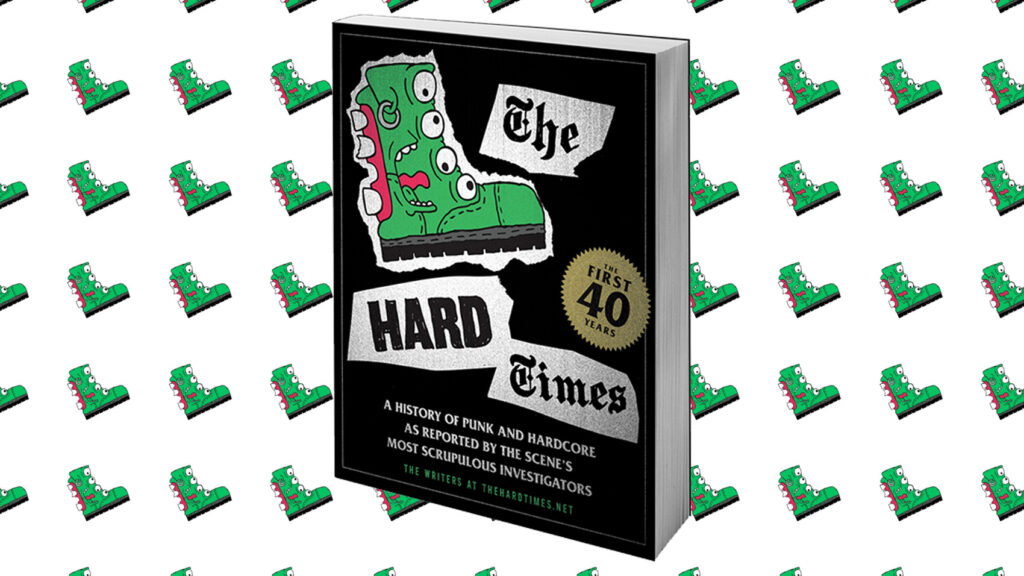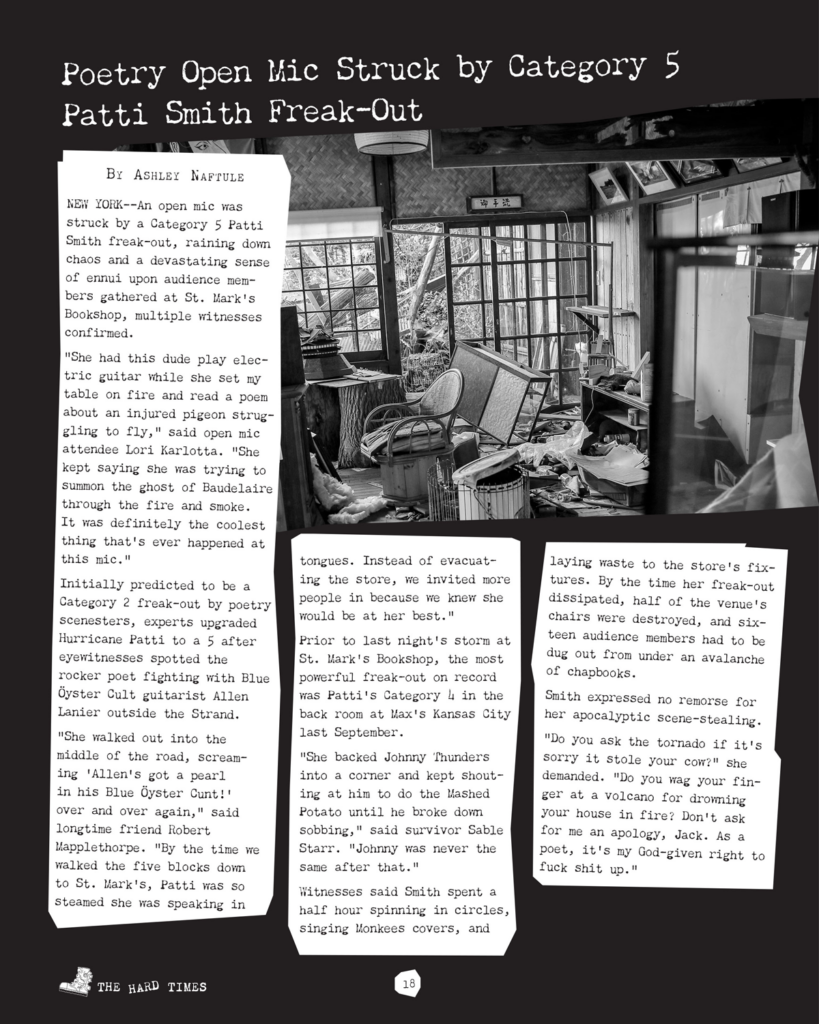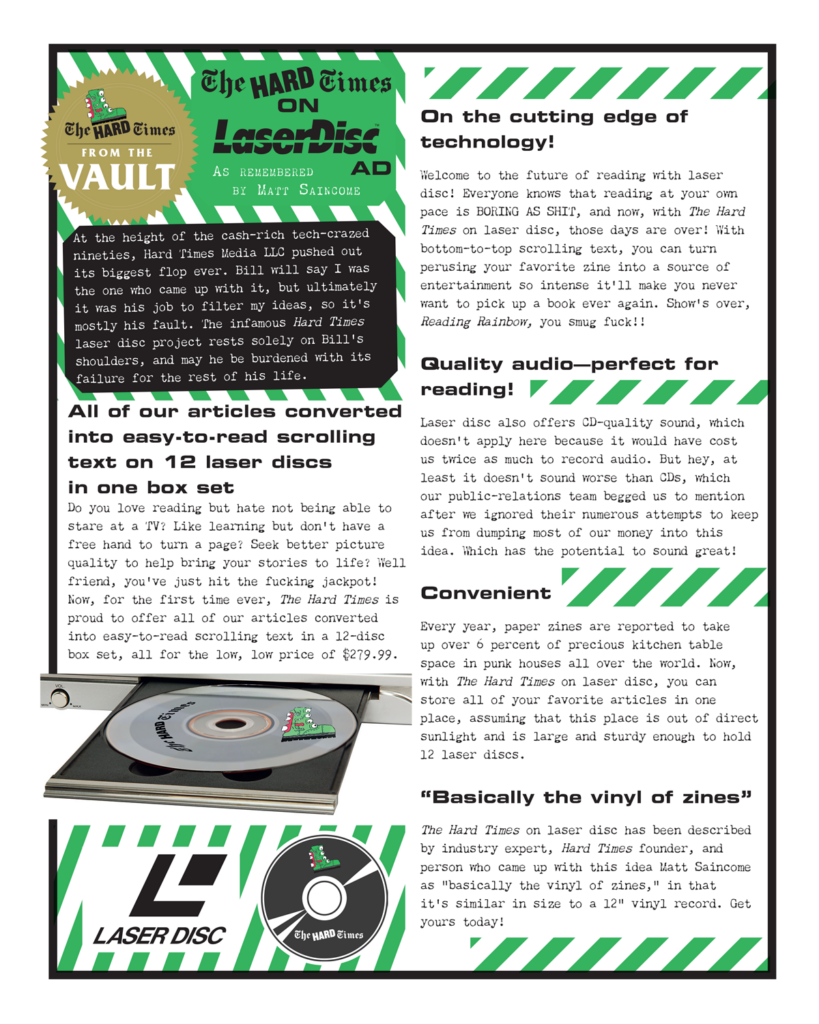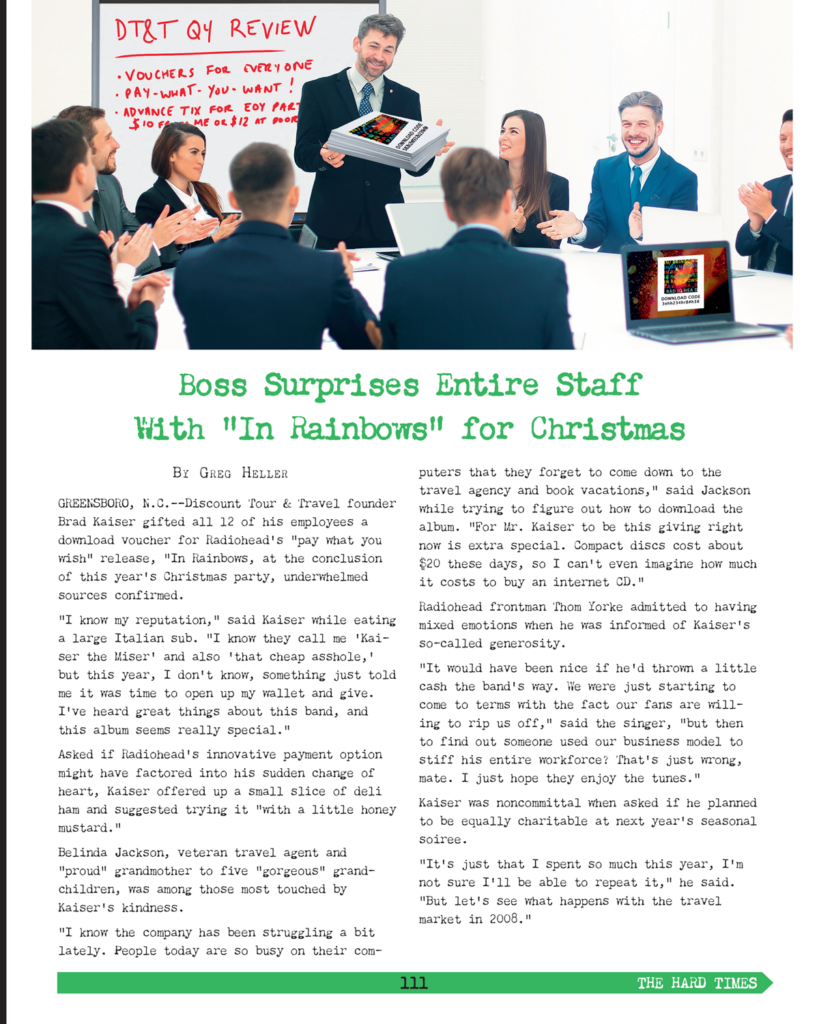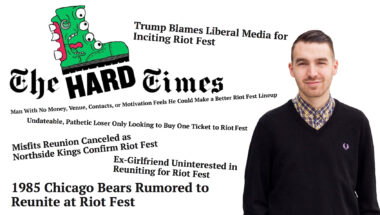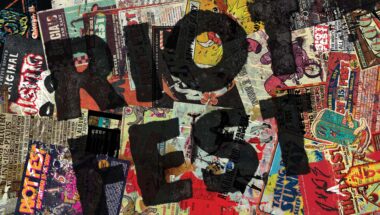The Hard Times: The First 40 Years is the greatest punk book I’ve ever read. This might not be so bold of a proclamation considering that I haven’t read a “punk book” of any sort in recent memory, but this one fits the bill: messy typewriter fonts and crooked collages of text contribute to a slightly photocopied, thrown-together appearance. It works.
In the five years since it launched (not quite the “40 years” suggested by the book’s psuedo-backstory), The Hard Times has become a part of the fabric of online punk life, a beloved DIY-culture touchstone for anyone who’s toured in a van or put on a (low turnout) show. Articles circulate primarily through Facebook feeds and Instagram stories; The First 40 Years is the first physical, totally-offline way to be in on the joke.
Managing editor Bill Conway and editor-in-chief Matt Saincome have wanted to put out a book ever since the site started (and pretty quickly blew up) in 2014, but it wasn’t until a publisher reached out that intended to make a Hard Times book their first project on the job. “Our publisher normally just puts out textbooks for middle schoolers,” Saincome jokes.
More than just past headlines fill up the book’s 256 pages, though; inside, you’ll find anything from LaserDisc ads to a tutorial on shoplifting Wendy O. Williams. There’s a wealth of new material covering the past four decades of underground history, all intertwined with The Hard Times’ own supposed 40-year past in publishing. The book had 91 different contributors—the website has a powerhouse of over 300 writers—but Conway and Saincome are the only two Hard Times staff working full time. It’s the kind of creative endeavor that yields a high reward at the risk of burnout, but luckily their hard work has paid off.
Riot Fest got to chat with Saincome and Conway on the how the book actually got finished, searching for an offline audience, and how the site’s left-of-the-dial form of operating has helped it thrive.
When did you start talking about doing a book and moving into the print territory? What was the main push for that?
Bill Conway: Ever since we started the site, people were like, “Oh, you guys need a book.” And we were like, “Well, we don’t have enough material for a book.” So people had been commenting here and there for a long time. Eventually, four years into the site or whatever, we started to think about it more and we were looking in the self-publishing route.
Then came along this editor that had just changed jobs—she emailed us out of the blue, and it just turned out we happened to be in the right spot. She guided us through the book proposal process; We came up with the idea that we wanted to put the “best of” articles in the back of the book, but we also wanted a bunch of new material because people can go find the stuff for free online if they so want to.
So we figured we needed to expand our scope a little bit and give a history of the site that started in 1976 and has gone through ‘til today. And that’s where you see the narrative in the book that goes through where Matt and I basically hate each other for awhile and all that stuff.
Matt Saincome: I just realized there’s a Riot Fest reference in there. Did you catch that one?
I didn’t! What was it?
MS: Bill, somewhere deep in the narrative, don’t I lie to you to say that there was money on the table for a Riot Fest reunion to try and get you back in the office?
BC: That’s a possibility. I mean, I do kind of forget what we have actually written at this point because, yeah.
MS: I think so. When everything falls apart, I think someone tells us that there’s a bunch of money for a Riot Fest reunion and that’s what forces us to get back together.
BC: Right. I found the Riot Fest references on page 115, and in the intro to the 2010s. But yes, there was only one way to reunite the original Hard Times lineup, and that’s to pay them a ton of money.
It’s interesting that you went the route of going through the decades of punk history through the past “40 years” of running The Hard Times given that most of your writers, I’m guessing, are not that old.
BC: I’m 35 years old, so the early 2000s is when I came up in punk and hardcore and stuff like that; those references I get. But none of our writers or contributors are really 40 to 50 years old. So those old 70s and 80s references were the hardest to come up with and make actually feel true to the times. I feel like so much of the reason our website works is because of the fact that we can say that we’ve done these things, we were there at similar types of shows. But obviously we couldn’t have been in a spot to see Bad Brains in 1982 if we were not alive at that point.
So we’re kind of going off… not guesswork, but kind of our best chance at trying to seem authentic writing these 80s and 70s—and at some point the 90s as well—references and jokes. Hopefully it lands with people.
The artwork for each decade feels authentic to the times, too. Who did the layout?
MS: HMH actually had an in-house guy who was a punk kid, he had been designing punk stuff for a long time. There’s actually an article in Rolling Stone where Henry Rollins shouts him out as the best designer. I don’t remember his name off the top of my head, but it is credited in the book and that’s the guy. We gave him feedback and what our vision was, and he made it all come to life.
I love that I know what decade I’m reading about just by the kind of visual layout. That’s the kind of detail I sweat about.
MS: We did a really weird thing where we were able to convince a publisher that we should have five visual layouts for the book and only four should be full color. [Laughs]
Are you guys looking to kind of expand your audience into an offline area? Something that somebody could pick it up at a bookstore and then follow the site?
MS: So I was thinking about the idea of expanding into offline; It’s very important to me. I’ve always been a big fan of physical media. I feel like it’s a little bit of a monument to what you’ve accomplished, especially when you consider the obstacles The Hard Times has faced and what we’ve done. I really liked the idea of the book as a monument to the years of work that we’ve put in to say, “Hey, we exist!” But you don’t need to be a fan of The Hard Times to like this book. All you need to be a fan of is underground music.
I wonder if there’s a chance here that a mom could buy this book for a son or daughter who has dyed hair and is always late to school or whatever. Buy this book for them, and that might be their first introduction to The Hard Times. There might be people who first experienced the book at a Barnes & Nobles and then looked up the website. I think if you’re really into punk, I think you’ve probably heard of Hard Times. But if you haven’t heard about it on Facebook, I could see this book stumbling into the hands of someone and turning them onto the whole thing.
When I used to work in print media at SF Weekly, there was this whole notion with the ads about how a print ad lasts forever. You might pay for one month, but people put newspapers down on their birdcages, to cover up their windows, and your ad might get way more impressions than you’d ever think because you’ve printed so many of them. I hope we see a little bit of that with The Hard Times. I would be interested if one day if I could ever talk to or meet someone who hears about us for the very first time via the book.
BC: I think about the old Onion anthology book. I feel like I got introduced to The Onion from being at a Borders or something like that, and picking up just one of their old books and being like, “What is this?” and then getting turned on to The Onion through that. They didn’t have hard copies of The Onion in suburban Massachusetts on the street corners. They only had them in New York, or wherever. I mean obviously, that was 19 some odd years ago when Borders stores actually existed and were around much more often. But who knows.
I feel like what you said, Matt, definitely is a possibility of just some kid picking the book up and saying, “What’s this weird green boot?” Opening it up and saying, “Oh wait, this is funny. Well, let me dig into this more!” And then you have somebody that gets turned on to it at age 12 all of a sudden, and hopefully they stick around for years.
MS: It’s interesting too because there’s all these engagements and interactions that we can track—how many people liked this thing, this guy unliked the page after this post, you can track these things. I’m curious about the statistics around the book that we can’t track. There’s guys like my dad who don’t have Facebook, but who are music collectors and they know all about different genres and music. And if they saw this cool punk book, they might pick it up. I’m interested to see how many of those types of people pick up this book and then how many of them go back to it a couple times and how many of them put it on their coffee table. You can’t track those engagement numbers. You can’t see how many people currently have this book on their coffee table or how many pizza shops bought this book because they’re a punk pizza shop and they just wanted to have it for their customers.
BC: Or how many barbershops it’s sitting on the waiting room table.
MS: Right. Those engagements to me are worth so much more than a Facebook like. And so those are the ones that I hope we can do well with. Punk, it’s kind of like… I guess they’re called third places, these little community hubs—a record store, or a barber shop, a used clothing store—where punk kids congregate around when they’re younger. A skate shop would be a good example. A pizza place with a punk theme. I would love it if the Hard Times books were there and people went with their punk friends and then they saw the book and that’s how they were introduced to us.
And even for folks who use Facebook regularly, you still miss a lot of stuff in your feed due to Facebook’s algorithms. Or maybe you just don’t get on that often at all. For the few pages like the Hard Times or some other page that I enjoy I’ll go back and scroll through their page to keep up. But with a book, that’s right in front of you and feels permanent.
MS: Yeah man, I hope… I think I’m going to do a little work to try to make sure that the book gets into these little punk community spaces, just like barber shops and pizza shops and record stores and skate shops.
BC: Tattoo shops.
MS: Tattoo shops, yeah.
BC: I’ve grown up skateboarding and getting tattooed, but especially with skate shops, there’s something about that community space when you’re younger. You go in there and whatever’s in there is cool to you. So if this book is sitting around down on the counter of a skate shop and some kid picks it up one day and just looks at it, all of a sudden that’s a cool thing to him. I can still vividly remember just lurking around skate shops, kind of just listening to the older kids talking. And then if there was a book like this and I picked it up as I’m transitioning into getting into punk, it probably would’ve made a big difference.
You guys have a lot more open of a process with your staff, at least from what I’ve heard—pitches go in a giant Facebook group, people vote on stuff, and it offers up different perspectives on different topics. Did that type of open door environment help with the book at all?
BC: Yeah, it definitely did. When we were coming up with the premise of the book, the three editors of the book—Matt, Krissy [Howard] and I—we tried our best to come up with our own headlines. Then we put it out to the group and saying “Here’s the parameters of what we’re looking for in the 70s, 80s, 90s and 2000s headlines.” And even if it wasn’t the headline that we used, if more than four or five people were pitching on a certain topic then we could zero in on—like MySpace top eight—we can focus on this one topic and get the best headline possible for that.
A giant part of this book is the fact that we have our pitch group—it’s democratic and people are so passionate about writing for the site.
MS: Yeah. It’s a crazy big group project with a bunch of punks, and somehow it works. I mean, I’ve never written for any site where it runs like our site. I think we’re probably some of the only people that do that and it definitely sets us apart and it gives us a different vibe. There’s pros and cons, but I definitely think there was a lot of pros when we were making the book.
Something I noticed in the book is the evolution of technology and its implications on music over the decades. I laughed at article about the boss giving the entire staff Radiohead’s In Rainbows for Christmas, because I remember how big of a deal that was: giving out an album for free. I mean, that’s what everyone just does now anyway. You have to give your shit out for free on Spotify. So for that to be stuck in this kind of punk history book, there’s actually a pretty throughline tale of how technology has changed and how we’ve kind of moved fast enough to forget a lot of it.
MS: Yeah, that’s definitely part of what we were conscious of when we’re pitching the book: What are some milestones of these decades that we can touch on? And I feel like the 2000s was especially that kind of like, peer-to-peer thing we wanted to touch on—maybe a stream, like Napster or Kazaa or something like that, which I don’t think actually made the book. But then the rise of social media and stuff like that all gets touched on as you go through. But earlier in the book, there’s things about CDs and stuff like that. More people are listening to the CDs, but in the 80s, it’s more about zines or whatever and so on and so forth. As you go back in time, the media actually changes as well that we talk about in the book.
I had read in the past about a TV pilot that was being worked on, but what else are you guys interested in moving into?
MS: Maybe we’re out of ideas. Maybe that’s it.
BC: The book’s everything.
MS: The book was the last dying gasp of creative energies. [Laughs]
I don’t know. It’s kind of a weird thing we do. We do a weird thing together that we create these comedic projects and then I certainly hope there’s more in store. I got a bunch of stuff that I want to do. I’m very interested in podcasts right now and I got a whole bunch of those I want to pull off. We’re small; we’re a mom and pop shop in some aspects, so we have some bandwidth issues. We can’t quite do everything at once, so we have to focus on the book and make sure that all gets lined up great.
But yeah, podcasts, merch—we’ve got some really cool merch items coming up. Unique ones, not just logos on t-shirts. We’re reigniting the efforts for that pilot. So yeah, we’ll see how far we get. Maybe this is the end, Bailey. Maybe you’re the last person to ask us any questions.
The Hard Times: The First 40 Years is available now via Amazon, Barnes & Noble, BAM!—and hopefully at your local crust punk hideout soon.
